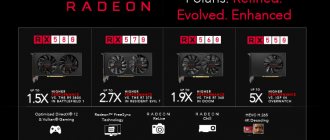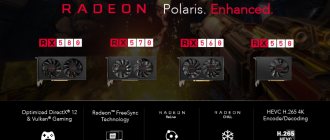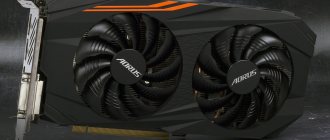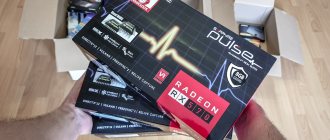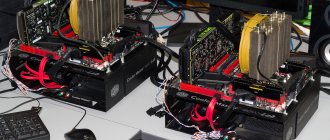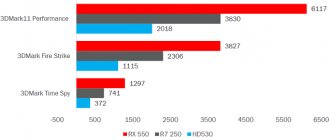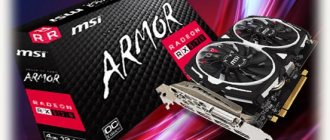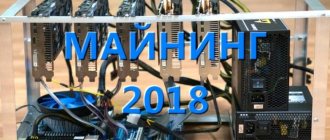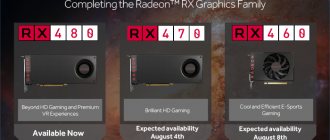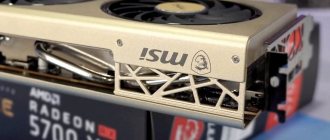We recently tested AMD's top-end video card based on second-generation Polaris silicon - Radeon RX 580. As tests showed, a deep revision of the chips' circuit design and the mature 14 nm FinFET process met the expectations placed on them, significantly increasing the "quality" of the crystals. The reserve acquired in this way was fully invested by AMD in GPU clock frequencies, which, even within the reference specifications, increased enough to ensure conditional parity in performance between the Radeon RX 580 and GeForce GTX 1060.
Compared to its main competitor, the Radeon RX 580 can offer the buyer such advantages as a larger amount of RAM (8 versus 6 GB) and the ability to work in multiprocessor configurations, which NVIDIA in the current generation has deprived of video cards of a lower rank than the GeForce GTX 1070. However, The smaller microarchitectures underlying AMD and NVIDIA chips have already diverged so much that many of today's games give a clear preference to one or the other of the GPU manufacturers, and at the moment the balance among AAA projects is not in AMD's favor. At the same time, although the developer set a recommended price for the version of the RX 580 with 8 GB of RAM below the level of the GeForce GTX 1060 ($229 versus $249), at retail these models occupy the same price range.
Today on the agenda is the second oldest video card of the 500 series - Radeon RX 570, which, being the successor to the Radeon RX 470, shared with the Radeon RX 580 all the advantages of the second generation Polaris. She will have to fight with younger modifications of the GeForce GTX 1060, equipped with 3 GB of RAM and a partially deactivated graphics processor. Let's see if AMD managed to make a more compelling offer in the sub-$200 graphics card sector than in the $230+ category.
⇡#GPU
The Polaris 20 graphics processor is a circuit-level redesigned version of the Polaris 10 chip with the Graphics Core Next 1.3 microarchitecture, which AMD used in the Radeon RX 470 and RX 580. As a result, the core has not undergone any functional or quantitative changes. Here is a brief description of Polaris and GCN 1.3, and you can get more detailed information in our review of the Radeon RX 480.
In AMD's production plans, the Polaris family represents an interim milestone on the road to a major update to the Graphics Core Next (GCN) architecture that the next generation of Vega chips will bring. Innovations in Polaris chips should correct weaknesses that have held back the performance of previous products built on GCN version 1.2 logic (GPU Tonga and Fiji). First on this list is color compression with ratios of up to 8:1, allowing more efficient use of RAM bus bandwidth. Another weakness of the AMD architecture - the speed of the early stages of the graphics pipeline that performs the projection and transformation of polygons - is compensated by the optimization of the geometry engine, which in GCN 1.3 is capable of cutting off polygons of zero size or polygons that do not have pixels in the projection at the early stages. The Compute Unit (a universal GCN unit that combines shader ALUs and texture mapping units) has also been tuned in Polaris to improve its specific performance.
In the field of general purpose computing (GP-GPU), GCN version 1.3 brought support for half-bit number formats - int16 and FP16, which are used in tasks that do not require more precise representation (such as the so promising machine learning today).
The updated multimedia unit allows hardware encoding and decoding of video in HEVC Main 10 and VP9 formats with resolutions up to 4K. The display controller supports DisplayPort 1.3/1.4 and HDMI 2.0b high dynamic range (HDR) output.
AMD Polaris 20 XL GPU Block Diagram
⇡#AMD Radeon RX 570: technical specifications, price
The Radeon RX 570 and RX 580 have the same configuration of active GPU compute units as the Radeon RX 470 and RX 480, respectively. The Radeon RX 570 has lost 4 of the 36 CUs found in the Polaris 20. As a result, at the same frequency, the RX 580 is superior The RX 570 is only 13% faster in shader operations and texel filling. At the same time, the Radeon RX 570 received an unchanged back-end of the graphics processor, including 32 ROPs and a 256-bit memory bus.
Since we are talking about an improved version of the flagship Polaris chip, both TDP and clock speeds have increased in the Radeon RX 570 compared to the RX 470. If we compare the Radeon RX 470 and RX 570, on the one hand, and the RX 480 and RX 580, on the other, the difference in TDP of video cards of the previous and new generations is approximately the same - 23 and 25%, respectively. But the changes in the clock frequencies of the Radeon RX 570 graphics processor are confusing at first: AMD only raised the maximum frequency by 60 MHz and at the same time the base frequency increased by 194 MHz. Apparently, the thermal package expanded from 120 to 150 W will simply allow the video card to reset the GPU frequency less often.
It is not so easy to predict how these changes will affect the speed of the accelerator. On the one hand, the increase in performance, which is completely insignificant according to “tabular” calculations based on Boost Clock, can turn out to be much higher in energy-intensive tasks. Moreover, in addition to overclocking the GPU, AMD increased the RAM bus bandwidth from 6.6 to 7 Gbps per pin, which also affects the overall power consumption of the accelerator. But, on the other hand, reference TDP values are not always valid for video cards of the original design. Since the reference Radeon RX 470 was only produced by SAPPHIRE, and the reference RX 570 is not available for sale at all, we wouldn't be at all surprised if we didn't find any actual performance difference between the reference-clocked Radeon RX 570 and the top-of-the-line Radeon RX 470.
Despite the increased TDP, the Radeon RX 570 (like the RX 580) should be more economical compared to its predecessor, and in certain scenarios - video decoding using a dedicated hardware unit and displaying images on multiple monitors with different refresh rates - quite significantly. In both cases, the load on the GPU 3D pipeline is minimal, but significant bandwidth is required from the RAM. The bus frequency typical for idle mode in Polaris 10/20 (1.2 Gbps per pin) is insufficient for this, so the Radeon RX 470/480 memory is clocked at the maximum frequency in such tasks, which accordingly affects the power of the device. The Radeon RX 570 and RX 580, on the other hand, introduced an intermediate state of RAM with a frequency of ½ of the maximum value.
| Manufacturer | AMD | |||
| Model | Radeon RX 470 | Radeon RX 480 | Radeon RX 570 | Radeon RX 580 |
| GPU | ||||
| Name | Polaris 10 | Polaris 10 | Polaris 20 XL | Polaris 20 XTX |
| Microarchitecture | GCN 1.3 | GCN 1.3 | GCN 1.3 | GCN 1.3 |
| Technical process, nm | 14 FinFET | 14 FinFET | 14 FinFET | 14 FinFET |
| Number of transistors, million | ||||
| Clock frequency, MHz: Base Clock / Boost Clock | 926/1206 | 1120/1266 | 1168/1244 | 1257/1340 |
| Number of shader ALUs | 2048 | 2304 | 2048 | 2304 |
| Number of texture mapping units | 128 | 144 | 128 | 144 |
| ROP number | 32 | 32 | 32 | 32 |
| RAM | ||||
| Bus width, bits | 256 | 256 | 256 | 256 |
| Chip type | GDDR5 SDRAM | GDDR5 SDRAM | GDDR5 SDRAM | GDDR5 SDRAM |
| Clock frequency, MHz (bandwidth per contact, Mbit/s) | 1650 (6600) | 2000 (8000) | 1750 (7000) | 2000 (8000) |
| Volume, MB | 4096 | 4096/8192 | 4096 | 4096/8192 |
| I/O bus | PCI Express 3.0 x16 | PCI Express 3.0 x16 | PCI Express 3.0 x16 | PCI Express 3.0 x16 |
| Performance | ||||
| Peak performance FP32, GFLOPS (based on maximum specified frequency) | 4940 | 5800 | 5059 | 6175 |
| Performance FP32/FP64 | 1/16 | 1/16 | 1/16 | 1/16 |
| RAM bandwidth, GB/s | 211 | 224 | 224 | 256 |
| Image output | ||||
| Image output interfaces | DL DVI, HDMI 2.0b, DisplayPort 1.3/1.4 | DL DVI, HDMI 2.0b, DisplayPort 1.3/1.4 | DL DVI, HDMI 2.0b, DisplayPort 1.3/1.4 | DL DVI, HDMI 2.0b, DisplayPort 1.3/1.4 |
| TDP, W | 120 | 150 | 150 | 185 |
| Suggested retail price (USA, excluding tax), $ | 169 (after reduction in autumn 2016) | 199/229 (at the time of release) | 169 | 199/229 |
| Recommended retail price (Russia), rub. | ND | 16,310 / 18,970 (at time of release) | 11 299 | 13 449 / 15 299 |
The recommended retail price of the Radeon RX 570 is set at $169 for the version with a standard 4 GB of RAM (video cards with 8 GB of RAM are also on sale). And yet, at the moment, it’s difficult to buy a new product for less than $199, which is how much the most affordable versions of the GeForce GTX 1060 3 GB cost. To be fair, we note that there is not yet an abundance of offers based on the RX 570 and these are mostly complex cards with powerful cooling systems and factory overclocking, while the GTX 1060 is available in modifications to suit every taste. This means that the price situation over time, as supplies of graphics processors and finished video cards increase, may still change in favor of the Radeon RX 570.
Alternative options
You will find all graphic cards in our always up-to-date rating. An alternative to the tested model can be video cards with a better price-quality ratio.
Video cards. All test results
Gigabyte GeForce GTX 1060 G1 Gaming 3G 3GB GDDR5
Productivity (80%) : 43.1
Equipment (5%)
: 77.6
Overall rating: 50.9
Price/quality ratio: 75
MSI GeForce GTX 1080 Ti Gaming X 11G 11GB GDDR5X
Productivity (80%) : 90.8
Equipment (5%)
: 68.2
Overall rating: 88.1
Price/quality ratio: 68
Zotac GeForce GTX 1070 Ti AMP Extreme 8GB GDDR5
Productivity (80%) : 70
Equipment (5%)
: 100
Overall rating: 73.2
Price/quality ratio: 89
Palit GeForce GTX 1060 Dual 3GB GDDR5
Productivity (80%) : 43.5
Equipment (5%)
: 68.2
Overall rating: 50.2
Price/quality ratio: 86
Zotac GeForce GTX 1070 AMP! Extreme 8GB
Productivity (80%) : 62
Equipment (5%)
: 100
Overall rating: 67.9
Price/quality ratio: 85
Video cards. All test results
⇡#SAPPHIRE Pulse ITX Radeon RX 570: technical specifications, scope of delivery, price
Like the Radeon RX 580, the junior accelerator on the Polaris 20 chip comes from day one in the form of expansion cards of an original design. SAPPHIRE coincided with the appearance of the Radeon 500 series with the debut of the new Pulse brand, under which the company united devices with a simplified design compared to the top-end NITRO family. In this review, the Radeon RX 570 will be represented by one of the two RX 570 models in the Pulse series, made in the Mini-ITX form factor. By the way, this is the first and currently only compact version of the Radeon RX 570 on the market, while the Radeon RX 470 and especially the RX 480 were produced only in the form of full-format boards.
At the same time, the Pulse ITX Radeon RX 570, among all the RX 570 variants that SAPPHIRE produces, is most similar to the reference version of this model: it is characterized by the standard frequencies and RAM capacity for the RX 570, and is also powered by a single six-pin additional power connector and has corresponding TDP of 150 W. For us, this is an ideal opportunity to compare the new product with the Radeon RX 470 version, which, in turn, operates within the 120 W thermal package standard for last year’s model.
Unfortunately, we cannot say anything about the current prices of the SAPPHIRE Pulse ITX Radeon RX 570, since the video card is currently not available in either foreign or Russian online stores. In the last batch on newegg.com it could be purchased for $185.
A patient buyer who waits for this model to be restocked will receive only a software disc and a set of paper documentation in the delivery package.
⇡#SAPPHIRE Pulse ITX Radeon RX 570: design
The compact video card fits without reservation into the limitations of the Mini-ITX standard and, in addition, has a completely unremarkable appearance. There is no backlight or protective plate on the back of the PCB.
A single fan with a diameter of 90 mm is installed in the cooling system casing. At the same time, the internal part of the cooler is designed quite well: the radiator is pierced by two heat pipes with a diameter of 6 mm, and the base is in contact simultaneously with the GPU, memory chips and voltage converter elements (an additional copper insert is provided for the graphics processor).
Temperatures and internal structure
- Length - 27 cm
- Noise ~36dB
As usual, we'll start our review with the cooler. The card is equipped with 2 95 mm fans.
Note: the manufacturer assures that the cooler protects the video card from dust. However, this is not the case, because with constant mining 24/7, the video card becomes covered with dust after 1.5-2 months.
The Bytwork team recommends removing the farm at least once every 2-3 months and completely venting the video cards. This will cool them down a little and extend the life of the fan, since dust will not interfere with its movement.
Removing the cooler reveals a thick radiator grille and copper heat pipes that remove heat from the card.
Heat pipes 2x8 mm and 2x6 mm run through the entire radiator grille.
The radiator grill itself looks really very massive. At the base of the radiator there is a copper plate. It has 58 pieces of aluminum nickel plated plates.
We also note that the card is equipped with thermal pads that cool the memory and VRM. It’s worth noting right away that after a couple of months of active mining, the gaskets sometimes start to leak, but this is a problem with many video cards.
As for the board itself, it is very well made.
The backplate reliably protects the back of the video card and is very well ventilated.
Plus, on the backplate side there is another thermal pad, which additionally cools the VRM area - this is very good.
So, it's time to move on to thermal images through a thermal camera.
Thermal photographs
| Measuring point | Degrees Celsius) |
| M1 | 73.9 |
| M2 | 66 |
| M3 | 58.3 |
| M4 | 51.5 |
| M5 | 43.2 |
| M6 | 44.9 |
| M7 | 27.8 |
M1 - GPU temperature at maximum load
M2 - VRM temperature (video card power supply area)
| Measuring point | Degrees Celsius) |
| M1 | 60 |
| M2 | 33.1 |
| M3 | 45.4 |
| M4 | 47.2 |
| M5 | 44.5 |
| M6 | 43 |
| M7 | 40.7 |
Temperature at full operation of coolers.
| Measuring point | Degrees Celsius) |
| M1 | 66.1 |
| M2 | 60.7 |
| M3 | 28.5 |
| M4 | 25.9 |
The overall thermal image looks great and the card does have a good cooling system.
⇡#SAPPHIRE Pulse ITX Radeon RX 570: board
Contrary to AMD's desire to abandon the DVI interface in reference design devices, SAPPHIRE installed one connector of this type on the Pulse ITX Radeon RX 570 chassis in addition to HDMI and DisplayPort outputs.
Hynix RAM chips labeled H5GC4H24AJR-R0C operate at standard speed - 7 Gbit/s per contact. The voltage converter includes four phases for powering the GPU and one for RAM chips. The six-pin additional power connector, together with the power lines in the PCI Express slot, provides the video card with a power reserve of 150 W - in exact accordance with the specifications of the Radeon RX 570.
⇡#Test stand, testing methodology
| Test bench configuration | |
| CPU | Intel Core i7-5960X @ 4 GHz (100 MHz × 40), constant frequency |
| Motherboard | ASUS RAMPAGE V EXTREME |
| RAM | Corsair Vengeance LPX, 2133 MHz, 4 × 4 GB |
| ROM | Intel SSD 520 240 GB + Crucial M550 512 GB |
| power unit | Corsair AX1200i, 1200 W |
| CPU cooling system | Thermalright Archon |
| Frame | CoolerMaster Test Bench V1.0 |
| Monitor | NEC EA244UHD |
| operating system | Windows 10 Pro x64 |
| Software for AMD GPUs | |
| All video cards | 22.19.147.0 WHQL |
| NVIDIA GPU software | |
| All video cards | GeForce Game Ready Driver 378.78 WHQL |
| Benchmarks: synthetic | |||
| Test | API | Permission | Full screen anti-aliasing |
| 3DMark Fire Strike | DirectX 11 (feature level 11_0) | 1920 × 1080 | Off |
| 3DMark Fire Strike Extreme | 2560 × 1440 | ||
| 3DMark Fire Strike Ultra | 3840 × 2160 | ||
| 3DMark Time Spy | DirectX 12 (feature level 11_0) | 2560 × 1440 | |
| Benchmarks: games | ||||
| Game (in order of release date) | API | Settings | Full screen anti-aliasing | |
| 1920 × 1080 / 2560 × 1440 | 3840 × 2160 | |||
| Crysis 3 + FRAPS | DirectX 11 | Max. quality. Start of the Swamp mission | MSAA 4x | Off |
| Metro: Last Light Redux, built-in benchmark | Max. quality | SSAA 4x | ||
| GTA V, built-in benchmark | Max. quality | MSAA 4x + FXAA + Reflection MSAA 4x | ||
| DiRT Rally, built-in benchmark | Max. quality | MSAA 4x | ||
| Rise of the Tomb Raider, built-in benchmark | DirectX 12 | Max. quality, VXAO off | SSAA 4x | |
| Tom Clancy's The Division, built-in benchmark | Max. quality, HFTS off | SMAA 1x Ultra + TAA: Supersampling | TAA: Stabilization | |
| Ashes of the Singularity, built-in benchmark | Max. quality | MSAA 4x + TAA 4x | Off | |
| DOOM | Vulkan | Max. quality. Foundry Mission | TSSAA 8TX | |
| Total War: WARHAMMER, built-in benchmark | DirectX 12 | Max. quality | MSAA 4x | |
| Deus Ex: Mankind Divided, built-in benchmark | Max. quality | MSAA 4x | ||
| Battlefield 1 + OCAT | Max. quality. Start of the Over the Top mission | TAA | ||
| Benchmarks: video decoding, computing | |
| Program | Settings |
| DXVA Checker, Decode Benchmark, H.264 | Files 1920 × 1080p (High Profile, L4.1), 3840 × 2160p (High Profile, L5.1). Microsoft H264 Video Decoder |
| DXVA Checker, Decode Benchmark, H.265 | Files 1920 × 1080p (Main Profile, L4.0), 3840 × 2160p (Main Profile, L5.0). Microsoft H265 Video Decoder |
| LuxMark 3.1 x64 | Hotel Lobby Scene (Complex Benchmark) |
| Sony Vegas Pro 13 | Sony benchmark for Vegas Pro 11, duration - 65 s, rendering in XDCAM EX, 1920 × 1080p 24 Hz |
| SiSoftware Sandra 2016 SP1, GPGPU Scientific Analysis | Open CL, FP32/FP64 |
| CompuBench CL Desktop Edition X64, Ocean Surface Simulation | — |
| CompuBench CL Desktop Edition X64, Particle Simulation— 64K | — |
⇡#Performance: 3DMark
Based on the results of synthetic tests, it is obvious that the power limit, increased in the Radeon RX 570 compared to the RX 470 by 30 W, does not give the new product a practically significant advantage. The difference in points between the RX 470 and RX 570 corresponds to a difference of 3% in the maximum GPU frequency, that's all.
Among other test participants, the Radeon RX 480, GeForce GTX 970 and GeForce GTX 1060 with 3 GB RAM are also almost equivalent to the Radeon RX 570 in 3DMark results, with a difference of up to 5% more or less.
On the other hand, there are video cards of the Radeon R9 380X class, over which the RX 570 has a confident advantage in both performance and power consumption, as well as significantly more productive models of the new generation - the Radeon RX 580 and the full-fledged GeForce GTX 1060.
| 3DMark (Graphics Score) | |||||||||
| Permission | AMD Radeon RX 570 (1244/7000 MHz, 4 GB) | AMD Radeon R9 380X (970/5700 MHz, 4 GB) | AMD Radeon RX 470 (1206/6600 MHz, 4 GB) | AMD Radeon RX 480 (1266/8000 MHz, 8 GB) | AMD Radeon RX 580 (1340/8000 MHz, 8 GB) | NVIDIA GeForce GTX 970 (1050/7010 MHz, 4 GB) | NVIDIA GeForce GTX 1060 (1506/8008 MHz, 3 GB) | NVIDIA GeForce GTX 1060 (1506/8008 MHz, 6 GB) | |
| Fire Strike | 1920 × 1080 | 11 872 | 9 215 | 11 609 | 12 310 | 13 904 | 11 117 | 12 191 | 12 890 |
| Fire Strike Extreme | 2560 × 1440 | 5 323 | 4 201 | 5 209 | 5 523 | 6 132 | 5 178 | 5 709 | 6 066 |
| Fire Strike Ultra | 3840 × 2160 | 2 628 | 2 123 | 2 626 | 2 701 | 3 032 | 2 467 | 2 708 | 2 891 |
| Time Spy | 2560 × 1440 | 3 639 | 2 817 | 3 569 | 3 953 | 4 202 | 3 511 | 3 811 | 4 107 |
| Max. | −19% | −0% | +9% | +17% | −3% | +7% | +14% | ||
| Average | −21% | −2% | +5% | +16% | −5% | +4% | +11% | ||
| Min. | −23% | −2% | +3% | +15% | −6% | +3% | +9% | ||
Performance: Gaming (1920 × 1080, 2560 × 1440)
Test results in games are not as clear as in “synthetics”. The Radeon RX 570 is still difficult to distinguish from the RX 470, but the balance of power when comparing the new product with other video cards from the AMD camp has changed. In particular, the advantage of the RX 570 over the Radeon R9 380X sometimes reaches 49%, despite the same amount of RAM. On the other hand, the Radeon RX 480 and RX 580, which have twice the RAM, are 24 and 31% faster than the RX 570 in some tests even at 1080p, and at 1440p the difference reaches 37 and 42%, respectively.
As for NVIDIA video cards, the current set of gaming benchmarks demonstrates the differences between competing architectures more clearly than ever. Even the GeForce GTX 970, equivalent to the Radeon RX 570 in terms of RAM, outperforms its opponent by 32% in some games, while in others, on the contrary, the RX 570 gains a 43% advantage. On average, there is a preponderance of 8–10% in favor of AMD.
The confrontation between Radeon RX 570 and GeForce GTX 1060 with 3 GB RAM is complicated by the difference in the amount of RAM. In most tests at 1080p resolution, the NVIDIA video card outperformed its main competitor, but those games that do not have enough 3 GB of RAM minimize the advantage of the lower version of the GeForce GTX 1060 even in 1080p mode. At 1440p resolution with full-screen antialiasing, the GTX 1060 with 3 GB of RAM can, in rare cases, compete with the Radeon RX 570, and generally provide an acceptable frame rate.
The full version of the GeForce GTX 1060 is not limited by memory capacity in any graphics modes up to Ultra-HD, so its performance level is on average 20% higher than that of the Radeon RX 570. Moreover, there are tests in which the advantage of the GTX 1060 reaches 35–37 % depending on resolution.
| 1920 × 1080 | |||||||||
| Full screen antialiasing | AMD Radeon RX 570 (1244/7000 MHz, 4 GB) | AMD Radeon R9 380X (970/5700 MHz, 4 GB) | AMD Radeon RX 470 (1206/6600 MHz, 4 GB) | AMD Radeon RX 480 (1266/8000 MHz, 8 GB) | AMD Radeon RX 580 (1340/8000 MHz, 8 GB) | NVIDIA GeForce GTX 970 (1050/7010 MHz, 4 GB) | NVIDIA GeForce GTX 1060 (1506/8008 MHz, 3 GB) | NVIDIA GeForce GTX 1060 (1506/8008 MHz, 6 GB) | |
| Ashes of the Singularity | MSAA 4x + TAA 4x | 22 | 18 | 22 | 24 | 24 | 29 | 26 | 28 |
| Battlefield 1 | TAA | 58 | 46 | 57 | 72 | 76 | 50 | 62 | 68 |
| Crysis 3 | MSAA 4x | 38 | 31 | 38 | 43 | 44 | 37 | 48 | 51 |
| Deus Ex: Mankind Divided | MSAA 4x | 22 | 17 | 21 | 24 | 25 | 19 | 15 | 22 |
| DiRT Rally | MSAA 4x | 51 | 39 | 49 | 54 | 57 | 46 | 60 | 65 |
| DOOM | TSSAA 8TX | 118 | 90 | 117 | 131 | 138 | 103 | 106 | 121 |
| GTA V | MSAA 4x + FXAA + Reflection MSAA 4x | 42 | 33 | 40 | 42 | 45 | 42 | 54 | 57 |
| Metro: Last Light Redux | SSAA 4x | 44 | 34 | 44 | 49 | 51 | 45 | 51 | 55 |
| Rise of the Tomb Raider | SSAA 4x | 30 | 24 | 29 | 32 | 35 | 21 | 14 | 35 |
| Tom Clancy's The Division | SMAA 1x Ultra + TAA: Supersampling | 51 | 34 | 51 | 58 | 60 | 42 | 44 | 56 |
| Total War: WARHAMMER | MSAA 4x | 35 | 26 | 34 | 38 | 39 | 33 | 40 | 43 |
| Max. | −18% | +0% | +24% | +31% | +32% | +28% | +35% | ||
| Average | −23% | −2% | +10% | +15% | −7% | +2% | +20% | ||
| Min. | −33% | −5% | +0% | +7% | −30% | −53% | +0% | ||
| 2560 × 1440 | |||||||||
| Full screen antialiasing | AMD Radeon RX 570 (1244/7000 MHz, 4 GB) | AMD Radeon R9 380X (970/5700 MHz, 4 GB) | AMD Radeon RX 470 (1206/6600 MHz, 4 GB) | AMD Radeon RX 480 (1266/8000 MHz, 8 GB) | AMD Radeon RX 580 (1340/8000 MHz, 8 GB) | NVIDIA GeForce GTX 970 (1050/7010 MHz, 4 GB) | NVIDIA GeForce GTX 1060 (1506/8008 MHz, 3 GB) | NVIDIA GeForce GTX 1060 (1506/8008 MHz, 6 GB) | |
| Ashes of the Singularity | MSAA 4x + TAA 4x | 18 | 15 | 18 | 17 | 19 | 20 | 20 | 21 |
| Battlefield 1 | TAA | 43 | 36 | 45 | 59 | 61 | 37 | 40 | 53 |
| Crysis 3 | MSAA 4x | 24 | 20 | 23 | 24 | 27 | 23 | 30 | 32 |
| Deus Ex: Mankind Divided | MSAA 4x | 12 | 10 | 12 | 16 | 16 | 10 | 5 | 14 |
| DiRT Rally | MSAA 4x | 37 | 28 | 35 | 39 | 41 | 36 | 21 | 45 |
| DOOM | TSSAA 8TX | 75 | 58 | 75 | 85 | 89 | 63 | 44 | 77 |
| GTA V | MSAA 4x + FXAA + Reflection MSAA 4x | 28 | 23 | 27 | 29 | 31 | 26 | 36 | 39 |
| Metro: Last Light Redux | SSAA 4x | 25 | 18 | 24 | 27 | 28 | 28 | 29 | 32 |
| Rise of the Tomb Raider | SSAA 4x | 19 | 15 | 18 | 20 | 22 | 13 | 3 | 21 |
| Tom Clancy's The Division | SMAA 1x Ultra + TAA: Supersampling | 36 | 24 | 37 | 42 | 44 | 31 | 31 | 40 |
| Total War: WARHAMMER | MSAA 4x | 23 | 17 | 22 | 26 | 26 | 20 | 18 | 28 |
| Max. | −16% | +5% | +37% | +42% | +14% | +25% | +37% | ||
| Average | −22% | −2% | +12% | +18% | −9% | −17% | +20% | ||
| Min. | −33% | −5% | −6% | +6% | −32% | −84% | +3% | ||
Review
The 4th Generation GCN graphics core architecture is the latest, innovative foundation of Polaris GPUs. Power-efficient Radeon Chill solutions, native support for critical next-generation APIs and the latest display technologies such as HDR and Radeon FreeSync 2.
Gaming on ultra settings
The following games were tested on ultra settings with the Sapphire Radeon RX 570 PULSE 8G 8GB graphics card:
- Wolfenstein II
- Forza Motorsport 7
- Battlefield 1
- Call of Duty: World War II
- Star Wars Battlefront 2
- Prey
Intelligent fan control system Fan Control III
SILENT COOLING. Enjoy complete silence under light workloads with a completely passive cooling system. No fans spinning means no distractions while working or relaxing.
PRECISION FAN CONTROL SYSTEM. In standard multi-fan cooling systems, fan speeds can vary by up to 10% under the same load. Now, thanks to the new fan controller, this difference has been reduced to 3.2% in SAPPHIRE NITRO+. Higher precision ensures improved cooling efficiency and reduced noise levels for each graphics card.
Radeon Chill
Radeon Chill dynamically adjusts frame rates based on your gaming behavior. Supports a huge number of games.
Enhanced Sync Technology – Ultimate smooth gaming experience like never before
AMD Radeon™ FreeSync technology eliminates stuttering and stuttering in games with fast, stutter-free performance at virtually any frame rate. Witness the next breakthrough in gaming performance.
Capacitors with a resource of 200,000 hours
High polymer aluminum capacitors provide outstanding reliability.
Metal reinforcement plate
The all-aluminum reinforcement plate provides additional rigidity to ensure no bending and prevents dust penetration. It also helps cool the graphics card, increasing heat dissipation efficiency.
Beautiful and stylish
The strict and stylish design of the video card allows it to look great in any case.
RADEON ADRENALIN EDITION SOFTWARE
From great to greatest Flawless design. Careful development. Incredibly intuitive. Perfect beauty
Radeon GPU Performance Comparison
⇡#Performance: video decoding
In all accelerators based on Polaris 10/20, the hardware multimedia unit is the same, and the performance ultimately depends entirely on the GPU clock frequency. In general, AMD's decoding speed for H.264 and H.265 formats does not shine in comparison with what NVIDIA video cards are capable of, but it is quite sufficient for playing video in resolutions up to Ultra-HD with a refresh rate of 60 Hz.
Note: since decoders usually do not differ within the same GPU line, the diagrams show one device from each family (or more if this rule is violated).
⇡#Performance: Computing
Most GP-GPU tasks in this price category favor AMD accelerators. Only in the CompuBench CL particle simulation test do NVIDIA GPUs have a clear advantage. It is noteworthy that it is in a number of computing tasks, and not in games, that the Radeon RX 570 has gone far ahead of the Radeon RX 470. GP-GPU, as a rule, loads shader ALUs most “densely”, and the additional 30 W of power allows you to maintain the GPU frequency at a high level.
Low hashrate on Ether RX 570 can be fixed with overclocking
If the Ether hashrate of the RX 570 has dropped, there may be several reasons:
- If the hashrate has dropped on the RX 570, then perhaps the issue is with the drivers and you need to install a more recent version.
- When the RX 570 has a low hashrate, you need to check whether the card is overheating. Perhaps this is the reason.
- If the AMD RX 570 has a lower hashrate, this may be due to incompatibility between the miner program and the OS. In this case, it is worth installing a more recent version of Windows.
If you think that the RX 570 8gb has a low hashrate, then it may be much higher than stated. It is better to overclock the GPU for mining using MSI Afterburner. The utility interface is very simple. To overclock the video card, we need two sliders:
- Core Clock – core overclocking, increases the core frequency;
- Memory Clock – memory overclocking, increases the memory frequency.
You need to change the frequency values little by little. Then test stability. If all is well, then you can increase the frequency further. If the video card starts to fail or the drivers crash, then simply reduce the frequency and that’s it. There will be no harm.
To increase the RX 570 8 gb hashrate, use the optimal overclocking parameters:
| Parameter | Meaning |
| Core Clock | +30 |
| Memory Clock | +1100 MHz |
| Power Limit | 76% |
| Temp. Limit | 70° |
⇡#Clock speeds, power consumption, temperature, overclocking
In Crysis 3 and other SAPPHIRE Pulse gaming tests, the Radeon RX 570 consistently maintains the maximum GPU frequency of 1244 MHz, and the supply voltage reaches 1.075 V. For comparison, the SAPPHIRE Radeon RX 470, which we tested last year, even at reference frequencies (up to 1206 MHz) requires a slightly higher voltage - 1.0938 V.
The cooling system fan rotates at speeds of up to 1727 rpm under load, and an average of 1481 rpm. At the same time, despite the compactness of the radiator, the video card is cooled no worse than other test participants.
Contrary to the passport data, in terms of power consumption in games and FurMark, the device differs better from the SAPPHIRE NITRO+ Radeon RX 470, despite the fact that we tested the latter with reference frequencies and a power consumption limit of 120 W, flashed into the backup BIOS chip. In comparison with NVIDIA accelerators, the new product is located in the gap between two versions of the GeForce GTX 1060 with 3 and 6 GB of RAM.
Among the overclocking tools in SAPPHIRE Pulse ITX Radeon RX 570, there is the ability to raise the power limit by 50% and the maximum GPU supply voltage by 0.2 V. However, as is the case with Radeon RX 470 models that have a single six-pin additional power connector, when If there is a serious increase in clock frequency, it is better not to touch the voltage slider. Otherwise, the video card will only throttle more often - dropping the GPU frequency below the maximum.
We managed to overclock the graphics processor to 1444 MHz, and the accelerator stably supported this level, and the memory chips maintained an effective frequency of up to 8 GHz. The GPU supply voltage automatically increased to 1.2 V. It would seem that the Radeon RX 470 version of SAPPHIRE NITRO+ overclocks better (up to 1460 MHz), but let's look at the details: the real GPU frequency of the overclocked RX 470 ranges from 1417–1425 MHz, and the voltage much higher is required - up to 1.3 V.
The SAPPHIRE card allows you to increase the fan speed up to 3711 rpm. Of course, this is incompatible with a comfortable noise level, but the GPU temperature in gaming tests decreased by 12 °C, despite the increased frequencies. As a result of overclocking, the computer's power increased by 26 watts. Only now the Radeon RX 570 has caught up with the power consumption of the Radeon RX 470 and RX 480 accelerators operating at reference frequencies!
What coins can you mine?
As mentioned earlier, the best mined coins are the Ethash and CryptoNightV7 algorithms. Also sometimes the Lyra2REv2 and CryptoNightHeavy algorithms work well.
Next are the algorithms that bring slightly less profit per day, but they can still be considered for mining: NeoScrypt, CryptoNightHaven, Lyra2z.
Well, at the end there are algorithms whose mining is not profitable - these are Xevan, X11, Equihash and many others.
Mined coins
| Algorithms | Coins |
| NeoScrypt | Crowdcoin, Dinero, Feathercoin, GoByte, Halcyon, Innova, Vivo, Trezarcoin, Orbitcoin, Phoenixcoin, 01 Coin, Agena, Airin, Akencash, Banq, Cerberus, CharmCoin, Coin2Fly, CoreZ, Desire, GoaCoin, HashRental, IQ Cash, Ignition, Kicker Romm, LuckyBit, Masterbit, Momo Cash, NyxCoin, Onex Cash, Qbic, Qyno, Rapture, Sigil, SimpleBank, Sparks, SunCoin, SuperLumic, Uniform Fiscal Object, ZCore, Zixx |
| CryptoNightV7 | Monero, BBSCoin, Citadel, DigitalNote, Elya, Graft, IntenseCoin, Parsicoin, NXB, MoneroV, Lethean, Kepl, Quantum RL, Superior Coin, Wownero |
| Ethash | Ethereum, Ethereum Classic, Ellaism, Metaverse, Expanse, Krypton, Ubiq, Soilcoin, Shift, Pirl, Musicoin, Akroma, Callisto, DubaiCoin, Nilu, MIX, Goldiam, MOAC, Ether1, EtherSocial, WhaleCoin |
| TimeTravel10 | Bitcore |
| Lyra2REv2 | Monacoin, Galactrum, Rupee, Straks, Vertcoin, Verge, Absolute, Exvo, HanaCoin, Kreds, MTI Coin, WeyCoin |
| X16R | Ravencoin, Motion, GPUnion, Gravium, Help The Homeless, Hilux, MoonDEX, XChange, Stone Coin, Sovereign, Proton Coin, OPL Coin, xGalaxy |
| X16S | Pigeoncoin |
| Lyra2z | Actinium, Alpenschilling, Criptoreal, GINcoin, Infinex, MCT+, Taler, Respawn, STIM COIN, Taler, Vertical, Zcoin |
you can use these algorithms on our website.
You can also .
⇡#Performance: overclocking
In synthetic tests, overclocking the Radeon RX 570 increases performance by 19%. This is enough to catch up and overtake the older video card of the Polaris family - Radeon RX 580.
| 3DMark (Graphics Score) | ||||
| Permission | SAPPHIRE Pulse ITX Radeon RX 570 (1244/7000 MHz, 4 GB) | SAPPHIRE Pulse ITX Radeon RX 570 (1444/8000 MHz, 4 GB) | AMD Radeon RX 580 (1340/8000 MHz, 8 GB) | |
| Fire Strike | 1920 × 1080 | 11 872 | 14 244 | 13 904 |
| Fire Strike Extreme | 2560 × 1440 | 5 323 | 6 317 | 6 132 |
| Fire Strike Ultra | 3840 × 2160 | 2 628 | 3 102 | 3 032 |
| Time Spy | 2560 × 1440 | 3 639 | 4 304 | 4 202 |
| Max. | +20% | +17% | ||
| Average | +19% | +16% | ||
| Min. | +18% | +15% | ||
However, in games everything is not as simple as in 3DMark. Often, there is really no difference between an overclocked Radeon RX 570 and an RX 580 at reference frequencies, but when more than 4 GB of video memory is required, the lower-end video card no longer stands a chance.
| 1920 × 1080 | ||||
| Full screen anti-aliasing | SAPPHIRE Pulse ITX Radeon RX 570 (1244/7000 MHz, 4 GB) | SAPPHIRE Pulse ITX Radeon RX 570 (1444/8000 MHz, 4 GB) | AMD Radeon RX 580 (1340/8000 MHz, 8 GB) | |
| Ashes of the Singularity | MSAA 4x + TAA 4x | 22 | 25 | 24 |
| Battlefield 1 | TAA | 58 | 67 | 76 |
| Crysis 3 | MSAA 4x | 38 | 43 | 44 |
| Deus Ex: Mankind Divided | MSAA 4x | 22 | 25 | 25 |
| DiRT Rally | MSAA 4x | 51 | 58 | 57 |
| DOOM | TSSAA 8TX | 118 | 138 | 138 |
| GTA V | MSAA 4x + FXAA + Reflection MSAA 4x | 42 | 45 | 45 |
| Metro: Last Light Redux | SSAA 4x | 44 | 54 | 51 |
| Rise of the Tomb Raider | SSAA 4x | 30 | 34 | 35 |
| Tom Clancy's The Division | SMAA 1x Ultra + TAA: Supersampling | 51 | 52 | 60 |
| Total War: WARHAMMER | MSAA 4x | 35 | 40 | 39 |
| Max. | +22% | +31% | ||
| Average | +13% | +15% | ||
| Min. | +2% | +7% | ||
| 2560 × 1440 | ||||
| Full screen anti-aliasing | SAPPHIRE Pulse ITX Radeon RX 570 (1244/7000 MHz, 4 GB) | SAPPHIRE Pulse ITX Radeon RX 570 (1444/8000 MHz, 4 GB) | AMD Radeon RX 580 (1340/8000 MHz, 8 GB) | |
| Ashes of the Singularity | MSAA 4x + TAA 4x | 18 | 20 | 19 |
| Battlefield 1 | TAA | 43 | 50 | 61 |
| Crysis 3 | MSAA 4x | 24 | 27 | 27 |
| Deus Ex: Mankind Divided | MSAA 4x | 12 | 14 | 16 |
| DiRT Rally | MSAA 4x | 37 | 42 | 41 |
| DOOM | TSSAA 8TX | 75 | 88 | 89 |
| GTA V | MSAA 4x + FXAA + Reflection MSAA 4x | 28 | 32 | 31 |
| Metro: Last Light Redux | SSAA 4x | 25 | 28 | 28 |
| Rise of the Tomb Raider | SSAA 4x | 19 | 22 | 22 |
| Tom Clancy's The Division | SMAA 1x Ultra + TAA: Supersampling | 36 | 37 | 44 |
| Total War: WARHAMMER | MSAA 4x | 23 | 26 | 26 |
| Max. | +17% | +42% | ||
| Average | +13% | +18% | ||
| Min. | +3% | +6% | ||
Mining performance
In mining, the video card produces the following hashrate indicators:
Hashrate
| Algorithm | MH/s (stock/overclock) |
| Ethash | 24/29 (MH/s) |
| NeoScrypt | 650/740 (Kh/s) |
| CryptoNightV7 | 790/847(H/s) |
| Equihash | 200/380(H/s) |
| PHI1612 | 8/11Mh/s |
| Lyra2z | 0.34/0.43Mh/s |
| X16r | 4.3/5.1Mh/s |
| TimeTravel10 | 7.4/8.1Mh/s |
| Lyra2REv2 | 28900/29600(Kh/s) |
| PHI2 | 2.2/2.7Mh/s |
⇡#Conclusions
Based on the reference specifications, the Radeon RX 570, unlike the Radeon RX 580, the replacement of Polaris 10 chips with second-generation silicon did not bring virtually any increase in performance in gaming tests. Large improvements are noticeable only in non-graphical calculations. Of course, AMD has increased the power limit available to the graphics card to ensure higher GPU clock speeds. However, many versions of the RX 470, especially those equipped with an eight-pin auxiliary power connector, already easily support peak frequencies.
On the other hand, at reference frequencies under gaming load, it is the RX 570 that consumes less power than the RX 470, and not vice versa, as follows from the data sheets of both models. Moreover, to overclock to frequencies beyond the capabilities of most RX 470 models, the new product required a much lower GPU supply voltage, and full-format modifications of the Radeon RX 570, with a powerful cooling system and an eight-pin additional power connector, will certainly allow one to reach greater heights.
In terms of price positioning, the Radeon RX 570 was initially in a better position than the Radeon RX 580. Although both models are cheaper than their main rivals at recommended prices, the actual prices for the Radeon RX 570 and GeForce GTX 1060 with 3GB RAM, on the one hand, and the Radeon RX 580 and GeForce GTX 1060 with 6 GB RAM, on the other, start at the same marks. In this case, whose proposal is more advantageous in terms of technical merits - AMD or NVIDIA?
As we remember, in the confrontation between the Radeon RX 580 and the GeForce GTX 1060 6 GB, an unstable parity has developed, but the RX 580 is losing ground in the priority resolutions for GPUs of this level, 1080p and 1440p. The Radeon RX 570, on the contrary, even in the lower configuration with 4 GB RAM has on average the same, and most importantly, more predictable version of the GeForce GTX 1060. Whatever one may say, 3 GB RAM in modern games is not enough even in 1080p mode, not to mention already about higher resolutions. At the same time, the updated Polaris silicon has narrowed the gap in power consumption between the RX 570 and the GTX 1060 with 3 GB RAM, provided efficient overclocking and made it possible to produce such compact models as the SAPPHIRE Pulse ITX Radeon RX 570. Therefore, we have no hesitation in awarding the victory in this round to the video card AMD.
Customer Reviews
In their reviews, buyers noted a lot of advantages of the video card, including: speed in games, expressive lighting, quiet fans, good cooling. The card's performance is sufficient for everyday work and comfortable immersion in most games with FullHD resolution with graphics settings close to maximum. According to buyers, the power of the video card will not be enough for gaming new products at the end of 2019 and the beginning of 2022, as well as for running games in 4K.
Users note that the video card fans stop without load, but under load they do not create any noticeable noise. The video card is factory overclocked, but the possibility of further overclocking highly depends on the specific instance and the manufacturer of the installed memory.
Among the shortcomings, some buyers noted the whistling of the throttles, which is noticeable only in absolute silence. Under heavy load, the fans spin up to 86%, and at such moments, of course, the video card is noisy.
In general, buyers agreed that the ASUS ROG Radeon RX 570 STRIX Gaming OC [90YV0AJ8-M0NA00] is the best card in its price segment, capable of running many modern games at 60 FPS in FullHD resolution.
Cheap means cheap. Reviewed by a US customer on October 24, 2022 Size: RX 580Style: DUAL RX 580 4GB OC [Verified Purchase] Beware of the Asus RX 580 Dual 4G OC Card. At first glance, the $200 RX 580 is an incredible deal, but there's a reason why it's so inexpensive. The memory modules are not cooled (see pictures) and this is completely unacceptable, especially considering that the RX 500 series, in my opinion, are largely overclocked cards of the previous generation RX 400. These memory chips will eventually burn out and make the card is useless. It's no wonder there are so many reviews on Amazon and Newegg mentioning dead cards.
Asus, this is unacceptable. Your engineering team could at least include a proper heatsink for this card to cool the chips around the processor. What were you thinking when you created this map? Trying to save customers a few bucks?
Review from a dissatisfied customer from Amazon
Large card with great cooling Reviewed August 15, 2022 by US Customer [Verified Purchase] Size: RX 580Style: DUAL RX 580 8GB OC The RX 580 graphics card is one of the best mid-range cards on the market. This, coupled with Asus' excellent cooling, makes the card a great addition for the hardcore PC builder. Pros: – Built-in heat detector that doesn't spin up the fans until the temperature reaches 55°C, so the graphics card doesn't make too much noise when idling under low load. – Overlocking is possible while maintaining a safe temperature index. – The graphics card is capable of running almost any modern A-class games. Make sure your processor isn't a weak point to get the most out of your graphics card. – Excellent price for a mid-range video card with an excellent cooling system.
Cons: – Cooling fans can get quite noisy if the load is heavy. Your typical modern games with impressive graphics will usually cause this. – Since this is a mid-range card, it may have problems with very graphics-intensive games, but it will generally run them too if the settings are slightly lower than the maximum graphics settings (cri; ~;).
Review from an American customer who was satisfied with the performance and cooling system of the video card.
